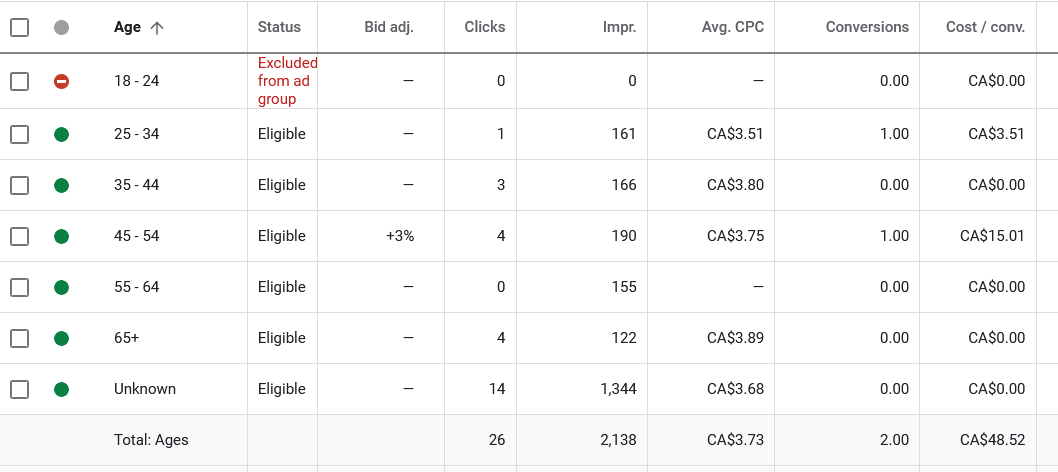
Once upon a time, U.S. Secretary of Defense Donald Rumsfeld noted: “…as we know, there are known knowns; there are things we know we know. We also know there are known unknowns; that is to say, we know there are some things we do not know. But there are also unknown unknowns—the ones we don’t know we don’t know. And if one looks throughout the history of our country and other free countries, it is the latter category that tends to be the difficult ones.”
In Google Ads, at the adgroup level for Search campaigns, we have the option (in eligible countries) to apply bid adjustments to demographic segments: gender, age, and household income. You can also bid to parental status in Display advertising, along with the aforementioned three demographic categories.

Figure 1: A brand new client, but valuable data is already beginning to trickle in as to the ages of people converting to a lead.
In every case, “Unknown” tends to be the largest of the segments. So we “don’t know,” and yet here, too, we may bid. It would be helpful to probe a bit to understand why these unknowns exist, in part to gain insight as to why there are so many of them, and why they shift around so much.
If I am manually bidding, I’m a big fan of these segments. I was pretty pleased, too, when household income was working at full steam for Canadian advertisers, on par with our U.S. counterparts. That’s a fairly recent development.
At the peak of “known,” we were seeing 80-90% of user sessions falling into the “known” buckets. That seems to be falling off a bit.
To begin with, we should be curious about how this information is actually known in the first place! It really speaks to the power of the user data a multi-tentacled tech giant and publisher like Google can amass. Just last week in Part 39, we covered some of the myriad ways that Google may be able to collect user data based on all of the properties it owns, making up a huge part of the daily existence of a large swath of humanity. Big Tech players like Facebook, Apple, Amazon, and Microsoft are in a similar position.
Knowing what age or gender a person may be could come from information the user volunteers and verifies when signing up for various services. This information could also be gleaned from statistical inferences.
What lies under the unknowns? The most obvious source of unknowns is from users who hide their identities using privacy protection. This could include browser settings, ad blockers, and VPN’s. There could also be privacy restrictions enforced by rival Big Tech players – iOS being a large part of that nowadays.
The fact that people shopping on iPhones might be less trackable to marketers explains a bizarro phenomenon we sometimes run across: Unknown outperforming known demographic segments. People with the latest iPhone might actually be really strong buyers of your products or services. That can explain the “Unknown is better” phenomenon. But we really don’t know, do we? It could be that privacy-obsessed users are more savvy, or have other characteristics that cause them to convert better for some businesses. Or they could be working in a privacy-heightened mode for a large employer – again, potentially a positive for conversion rates in some cases, as counterintuitive as that may seem.
It could also be the case that a given user is signed up for fewer Google services, rarely logs in, or shares a device or multiple devices with other people, such that assumptions around age, gender, etc. simply can’t be made with statistical confidence.
Wait! There’s more! If you’re opted into this at the campaign level, Search Partners make up a certain percentage of your total campaign traffic. Demographic data from users clicking ads from Search Partners is not shared with Google, so it goes into the Unknown bucket.
Flareups in Unknown traffic sometimes come about as a result of deliberately malicious clicks by bots or click farms (click fraud). These can be bad for your business. Google is pretty good at proactively or retroactively refunding such clicks.
Finally, Google reports anyone under age 18 as Unknown in age so advertisers don’t get the bright idea of targeting children for inappropriate products – or, for that matter, anything at all.
So, yes, the Unknown bucket contains quite a melange of ingredients, and will taste differently for you based on circumstances.
Now you know! (Or do you?)
Read Part 41: Vigilance is a Must for New PPC Accounts